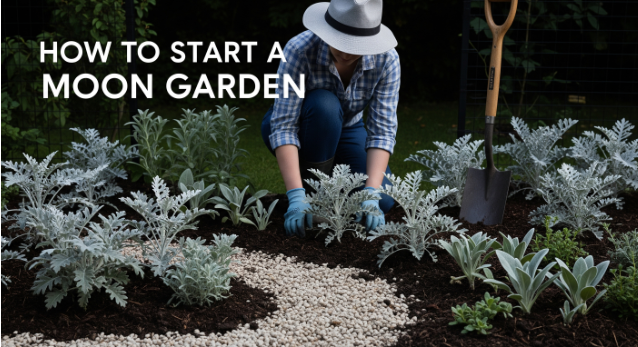
In a world increasingly obsessed with daylight productivity, a quiet gardening revolution is taking place—at night. Moon gardens, designed specifically to be enjoyed after the sun sets, are trending in 2025 for their tranquillity, beauty, and pollinator-friendly appeal. This guide will walk you through how to start a moon garden, from choosing the best night-blooming flowers to creating a sensory haven that comes alive under moonlight.
Unlike conventional gardens, moon gardens offer a unique sensory escape tailored for evening hours. They cater to busy individuals who only find time to unwind at night, creating a peaceful sanctuary free from the glare and bustle of daylight. These gardens are not only aesthetically appealing but also serve as calming spaces to connect with nature after dusk.
In this comprehensive guide, you’ll explore plant selections that glow under moonlight, learn how to use reflective surfaces and low lighting, and discover how to attract nocturnal pollinators. Whether you have a tiny balcony or a sprawling backyard, moon gardens are customizable for any space. Let’s step into this nocturnal oasis and unlock the serene magic of moon gardening together.
What is a Moon Garden? (And Why You Need One)
A moon garden is a specially designed outdoor space that glows and thrives in the evening hours. These gardens feature moon garden plants with white blooms, silver foliage plants, and strong fragrances that are enhanced by the cool night air. Inspired by historical concepts such as Japanese moon-viewing gardens, moon gardens are perfect for night owls, urban dwellers, and anyone craving evening serenity.
They allow you to unwind in your backyard or balcony after a long day, making them ideal for modern lifestyles where daytime gardening isn’t always feasible. Unlike traditional gardens that rely heavily on sunlight, moon gardens embrace dim light and subtle contrasts. Their peaceful atmosphere also makes them a favorite for late-night meditations or stargazing rituals.
Choosing the Right Location For Moon Garden in 2025
The first step in how to design a moon garden for small spaces or larger yards is selecting the perfect spot. Look for areas that are easily visible from your patio, windows, or sitting area. A location with partial moonlight exposure is ideal. If you’re working with limited space, balcony moon gardens or rooftop setups are perfect alternatives.
Make sure the site has good drainage and minimal artificial light, which can overpower the subtle glow of moon garden plants. Nighttime humidity levels can affect fragrance intensity and mildew, so choose a spot with some airflow. A space that’s peaceful and shielded from city noise will elevate the sensory experience of your moon garden.
Plants That Shine at Night
A moon garden thrives on the interplay of light, scent, and softness. Choose your plants carefully for maximum evening impact:
White & Silver Flowers
- Moonflower: Large white blooms that open at dusk
- Shasta Daisy: Classic white petals with a bright yellow center
- Dusty Miller: Silvery foliage that reflects moonlight beautifully
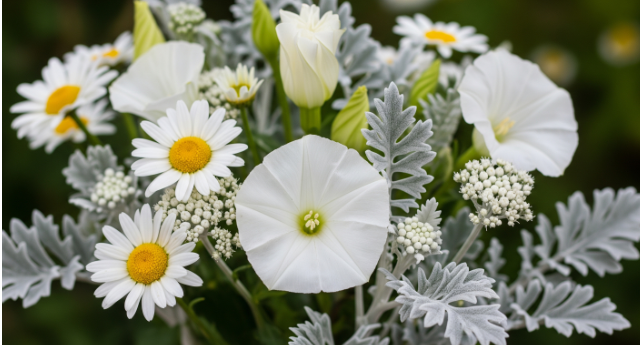
These flowers not only glow in moonlight but also provide contrast against dark garden backgrounds. Group them together for a luminous focal point. Their blooms often stand out even on cloudy nights, adding brilliance and texture.
Fragrant Night Bloomers
- Jasmine: Intensely fragrant and romantic
- Evening Primrose: Opens in the evening with a sweet scent
- Nicotiana: Also called flowering tobacco, very aromatic
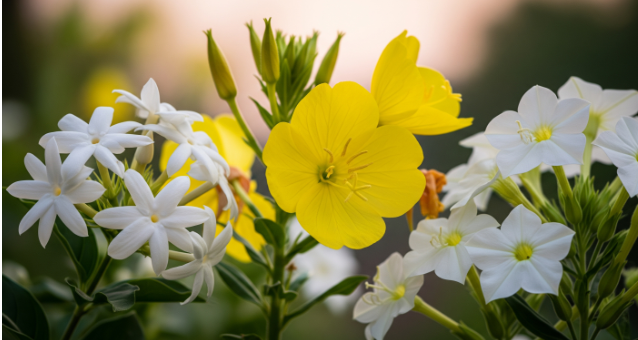
These plants release their strongest fragrance after sunset, enhancing your sensory garden experience. Plant them near entryways or seating areas for maximum effect. Their soft hues also add to the visual tranquility of your space.
Glowing Foliage
- Lamb’s Ear: Velvety texture and reflective surface
- Artemisia: Silvery tones and drought-tolerant
- Silver Thyme: Edible and ornamental
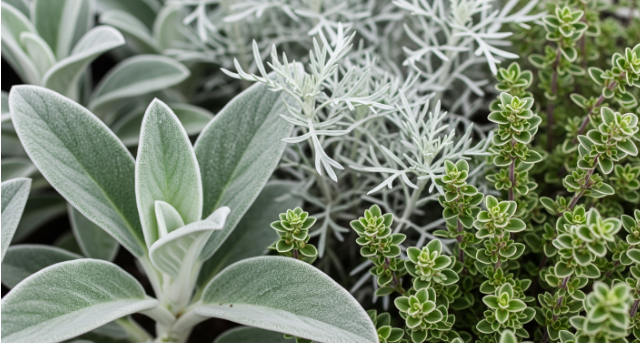
These foliage selections add structure and contrast throughout the night. They require minimal upkeep and thrive even in poor soils. Their shimmer effect under moonlight is subtle yet mesmerizing.
These night blooming flowers and foliage are must-haves for a vibrant and reflective nighttime garden.
Creating Sensory Appeal
A moon garden should engage all your senses:
- Fragrance: Plant fragrant plants for night gardens like lavender, gardenia, and night phlox near seating areas.
- Sound: Incorporate elements like rustling grasses, bamboo, or gentle wind chimes.
- Touch: Add soft-textured foliage like lamb’s ear and moss to enhance tactile experience.
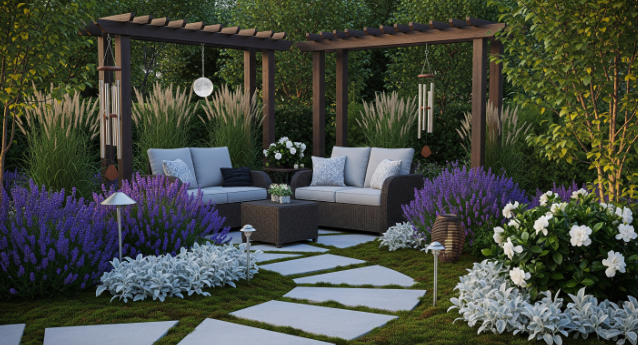
Adding a small bubbling fountain can also introduce soothing water sounds. Place textured stepping stones or wooden benches for touch and contrast. These layers turn your garden into a nighttime sanctuary.
Creating a multi-sensory space adds depth and peace to your evening routine.
Lighting Your Moon Garden Naturally
While the moon is your main source of light, some added touches elevate the ambiance:
- Reflective Surfaces: Use white stones, polished pebbles, or garden mirrors.
- Eco-Friendly Lights: Solar or LED options with cool tones work best.
- Path Lighting: Guide guests and highlight focal points with low lighting.
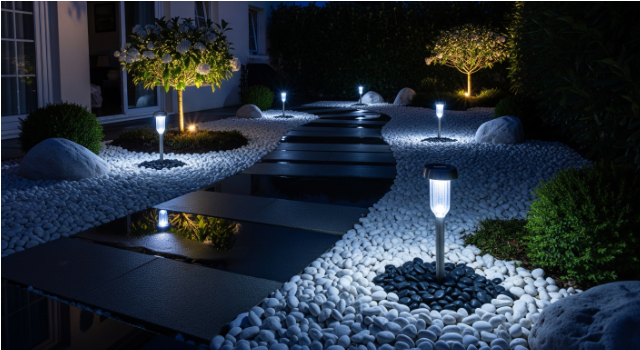
Incorporate lanterns made of frosted glass for a soft glow. Avoid upward-facing floodlights to preserve the night’s calm. Strategic lighting should support, not overshadow, the moonlight’s natural effects.
When choosing moon garden lighting ideas, avoid harsh lights that overpower the natural glow.
DIY Moon Garden Design Ideas
Your moon garden layout should mirror the celestial body it’s named after. Here are some design ideas:
- Raised Beds or Containers: Perfect for renters or patios
- Circular Patterns: Symbolic of the moon and great for flow
- Water Features: Still water reflects moonlight and attracts wildlife
Elegant Raised Beds for Moonlit Beauty
Raised beds add structure and depth to your moon garden while enhancing drainage and soil quality. Elevating night-blooming plants like moonflowers and evening primrose allows their silvery hues and fragrant blooms to shine under moonlight, creating a layered, glowing display
Container Magic for Small-Space Moon Gardens
Containers are perfect for balconies, patios, or compact yards. Use white or reflective pots to enhance the moonlight effect and group night-scented plants like jasmine or night phlox. Containers also make it easy to move plants for optimal moon exposure or seasonal change.
Practical and Stylish Moon Garden Beds
Raised beds and containers not only offer visual appeal but also make it easier to maintain your garden after dusk. They define pathways, reduce weeds, and can be filled with rich soil ideal for night bloomers. Add mulch or white gravel for extra brightness at night.
Circular Harmony: A Natural Flow for Moon Gardens
Circular patterns bring a sense of unity and calm to moon gardens, mimicking the shape of the moon itself. These flowing designs help guide the eye gently around the space, enhancing the meditative and tranquil atmosphere that moon gardens are known for.
Design in the Round: Circles That Reflect Lunar Energy
Incorporating circular beds, pathways, or seating areas adds a symbolic and visual connection to lunar cycles. Whether you arrange plants in rings or create moon-shaped borders, these patterns evoke the soft, cyclical rhythm of nature under the night sky.
This is an easy DIY moon garden layout for backyard or balcony spaces roof top.
Attracting Nocturnal Pollinators
One of the beautiful side effects of moon gardens is their attraction to night-time wildlife:
- Moths and Bats: Attracted by white flowers and fragrance
- Night Bees: Certain species like sweat bees are active at dusk
- Frogs and Owls: Benefit from the thriving insect life
Adding native plants increases your garden’s value for local ecosystems. Use shallow water dishes to support amphibians. These creatures also help control nighttime pests, making your garden more balanced.
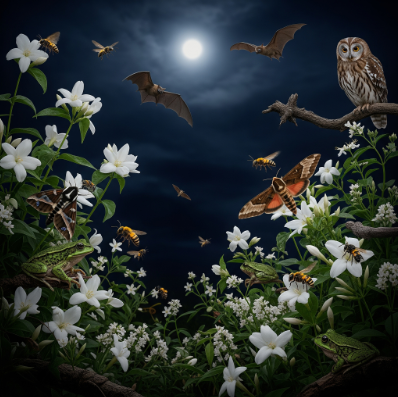
Choose pollinator-friendly night garden plants like four o’clocks, yucca, and angel’s trumpet.
Moon Garden Maintenance Tips
A successful moon garden requires a bit of nighttime TLC:
- Watering: Best done at dusk to prevent evaporation
- Pest Management: Watch for slugs and snails, common at night
- Seasonal Swaps: Change out annuals as seasons shift to keep the glow alive
Regularly check lighting setups for battery or solar panel wear. Prune blooming plants to encourage consistent flowering. Clear fallen petals and leaves to maintain visual appeal and prevent rot.
Mulch around plants to help retain evening moisture and suppress weeds, especially in summer. Monitor humidity and airflow to avoid fungal issues in dense planting zones. Also, use natural nighttime-safe fertilizers to nourish soil without harming nocturnal pollinators.
Inspect the garden weekly for any signs of disease or stress. Nighttime shadows can make it harder to spot early plant problems, so consider using a soft flashlight for evening checks. Removing yellowed leaves and deadheading spent blooms will help maintain both appearance and plant health.
During cooler seasons, protect sensitive plants with row covers or cloches to retain heat at night. Consider using heat-absorbing stones or dark mulch near tender plants to trap warmth from the day. These small interventions can extend bloom time well into autumn.
Lighting elements
Lighting elements, especially solar-powered ones, need periodic cleaning to function properly. Wipe them down every few weeks to remove dirt or dew buildup that might dim their output. Replace rechargeable batteries annually to maintain reliable lighting.
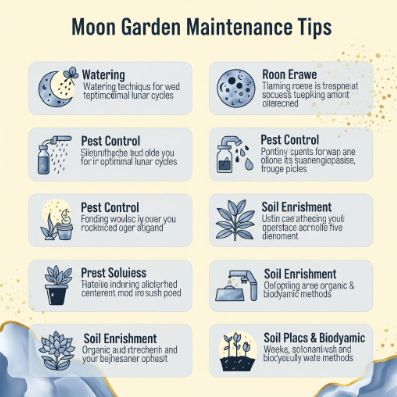
In high-humidity areas, be mindful of mildew on foliage or moss overgrowth on soil surfaces. Thin dense clusters of plants to allow better airflow. For natural pest solutions, release beneficial insects like ladybugs or apply garlic-based sprays after sunset.
Labeling your plants, especially herbs or perennials, can help track which ones thrive best under moonlight conditions. Use waterproof markers or engraved stones that reflect your garden’s theme. Keep a moon garden journal to track flowering cycles, light patterns, and maintenance needs.
Ultimately, consistency is key. A few minutes each evening to tend, observe, and enjoy your moon garden can keep it thriving all season long. This dedicated time fosters a deeper connection with your plants and offers a moment of peace at the end of the day.
Use this advice on how to maintain a moon garden through seasons for long-term success.
Benefits Beyond Beauty: Moon Garden for Wellness
Moon gardening is more than an aesthetic hobby—it’s therapeutic:
- Reduces Stress: Soft lighting and fragrance calm the mind
- Mindfulness Practice: Perfect for meditation or reflection
- Family Time: Great for storytelling, stargazing, and bonding
Reduces Stress
Spending time in a moon garden can improve sleep quality by helping you wind down. It creates a natural space for deep breathing and mental clarity. Children especially benefit from calming pre-bedtime nature rituals.
Exposure to plants at night has been linked to lower cortisol levels, supporting reduced anxiety and better emotional regulation. The rhythmic tasks of watering, pruning, or simply observing your moon garden can serve as a form of moving meditation. Unlike noisy daytime settings, the garden at night is peaceful, allowing your mind to reset.
For those with busy schedules, moon gardening offers a rare chance to reconnect with nature during hours typically reserved for screen time or indoor routines. As blue light from digital devices becomes a known disruptor of sleep and focus, moonlight gardening offers a healthier alternative. It restores balance to your circadian rhythm while keeping you grounded.
Mindfulness Practice
If you’re navigating grief, emotional burnout, or high-pressure work environments, a moon garden becomes a gentle refuge. The scents, sounds, and textures can evoke calming memories and provide space for mental clarity and emotional healing. Even short visits to the garden can have cumulative effects on well-being.
Couples can use moon gardens as a shared space for deeper conversations or romantic quiet time. Elderly individuals or those with limited mobility may find that moon gardens offer a safe and relaxing environment to engage with nature without harsh heat or sun exposure.
Family Time
Incorporating elements like wind chimes, night-blooming aromatics, or tactile pathways further strengthens the healing potential of your space. Moon gardens also pair beautifully with practices such as nighttime journaling, tea drinking rituals, or guided breathing exercises.
Over time, this sanctuary evolves into more than a garden—it becomes a place where your thoughts settle, your body softens, and your heart finds rest. Moon gardening isn’t just a design choice; it’s a lifestyle that nurtures the soul.
These are the therapeutic benefits of nighttime gardening that go beyond appearance.
Moon Gardening by Lunar Phases
Many gardeners believe in the power of the moon to influence growth. Here’s how to align your moon garden with lunar cycles:
- New Moon: Best for planting leafy greens
- Full Moon: Ideal for flowering plants
- Waning Moon: Prune, weed, or transplant
New Moon
Track the lunar calendar using a garden app or printed planner. Syncing tasks with moon phases may enhance plant vitality. It’s a spiritual and scientific approach that adds ritual to gardening.
Each phase of the moon has a gravitational influence on moisture levels in the soil, much like tides in the ocean. This subtle but impactful factor can affect seed germination, root development, and bloom production. When you align planting and maintenance activities with these phases, your plants may show greater resilience and more vigorous growth.
Waning Moon
The waxing moon phase (between new and full moon) is especially beneficial for planting above-ground crops and flowers. Sap flow increases during this time, which supports healthy foliage development. In contrast, the waning moon is best for planting root crops, dividing plants, or dealing with pests, as the energy is drawn downward.
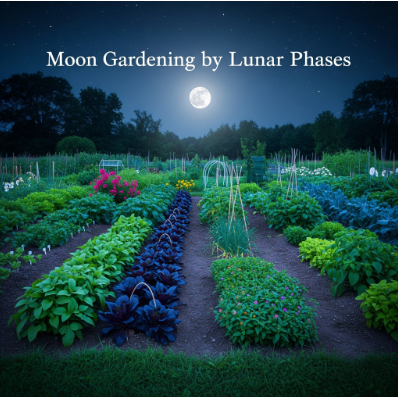
By observing moonrise and moonset times, you can also fine-tune your watering schedules to harmonize with cooler, moisture-rich hours. This minimizes evaporation and allows plants to absorb nutrients more efficiently.
Gardeners who follow lunar rhythms often report more meaningful connections to their gardens. It encourages mindfulness, patience, and observation—essential qualities in cultivating both plants and inner peace and consider creating a moon phase log where you document growth patterns, flowering times, and pest activity relative to the lunar calendar.
For better planning, follow moon phase gardening tips aligned with your local moon calendar.
Plantingwell.com is a dedicated gardening and organic farming website offering practical tips, how-to guides, and eco-friendly solutions for plant lovers of all levels. Whether you’re growing vegetables, herbs, flowers, or exploring sustainable farming techniques, PlantingWell.com provides expert advice on soil health, fertilizers, watering, pest control, and seasonal care. Our mission is to help you grow healthier plants while supporting environmentally responsible gardening practices.

